Regular polyhedra generalize the notion of a regular polygon to three dimensions. A regular polyhedron is a polyhedron with congruent faces and identical vertices. There are only five convex regular polyhedra, and they are known collectively as the Platonic solids, shown below. From the top left they are the regular tetrahedron (four faces), cube (six), octahedron (eight), dodecahedron (twelve), and icosahedron (twenty).
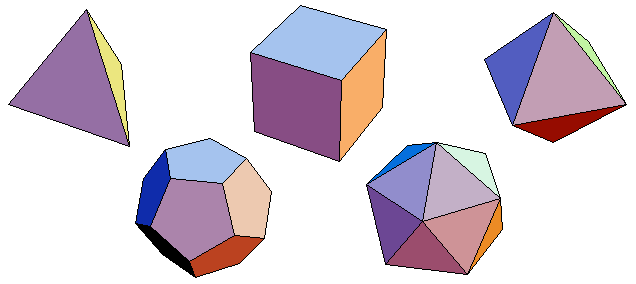
We will be interested in calculating the volume and surface areas of these solids. The situation is much different than with regular polygons because there are only five Platonic solids, so we will treat each of them separately. The notation is a bit more cumbersome, but we will always use the same variables. Let n denote the number of faces of the polyhedron. Let s be the length of an edge, Sn the total surface area, Vn the volume, r the distance from the center of the polyhedron to a vertex, and a the distance from the center of the polyhedron to the center of one of its faces. The definitions of the radius r and the apothem a make sense, for they are the radii of the circumscribed sphere and inscribed sphere, respectively. Let Ak(s) be the area of a regular polygon with k sides and side length s.
The surface area of the polyhedron is simply
where each face of the polyhedron has k sides.
As the area of a regular polygon can be found by breaking it up into congruent triangles, the volume of a regular polyhedron can be found by breaking it up into n congruent pyramids, where each face of the polyhedron is the base of one pyramid and the edges of the pyramids are the line segments from the center of the polyhedron to the vertices. The volume of the polyhedron is the sum of the volumes of its constituent pyramids (and the volume of a pyramid of height h and area of base A is h · A / 3):
| (1) |
(Notice the resemblance of this equation to the analogous equation for the area of a regular polygon: A = a p / 2. A similar relation exists for any number of dimensions.) Whereas it is fairly straightforward to find the volume of the first three Platonic solids without splitting them up into pyramids, computing that of the icosahedron is much easier by splitting it up.
For the cube, V6 = s3 and S6 = 6 s2. The apothem is a = s / 2. To find the radius r, we form a segment from the center of the cube to a vertex and another from the center of the cube to the center of a face touching that vertex. By the Pythagorean theorem,
so
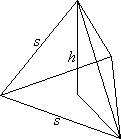 The surface area of the regular tetrahedron is
The surface area of the regular tetrahedron is
A segment drawn from a vertex to the midpoint of the opposite side has length h, the height of the tetrahedron. This segment forms a right triangle with a side length and the segment drawn from the midpoint of the base triangle to a vertex of that triangle. By the Pythagorean theorem,
so
Thus the volume is
The regular octahedron has surface area
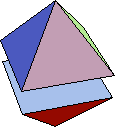 We find the volume of the regular octahedron by slicing it into two square pyramids (that have a common base). If h is the height of each of these pyramids, by the Pythagorean theorem we have
We find the volume of the regular octahedron by slicing it into two square pyramids (that have a common base). If h is the height of each of these pyramids, by the Pythagorean theorem we have
Thus h = s / √2, and the volume is
The surface area of the regular icosahedron is
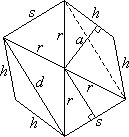
We compute the volume of the regular icosahedron by finding the apothem a and by finally employing (1). In the cross section to the right, the two edges of length s are opposite each other on the icosahedron and form a rectangle with the diagonals (of length d) of two regular pentagons. These pentagons have side length s and can be seen as the two-dimensional "border" of the icosahedron when looking at it. (In the drawing, these two pentagons lie in planes perpendicular to the page.) The four segments of length h are altitudes of triangular faces of the icosahedron. Again we use the Pythagorean theorem, obtaining two equations:
We have d = (1 + √5) s / 2 and h = √3 s / 2, so eliminating r and solving for a gives

By equation (1), the volume of the icosahedron is
The regular dodecahedron has total surface area
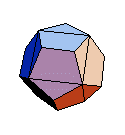
We will need more ingenuity in finding the volume of the dodecahedron, for the geometry is not as simple. However, there is an easier way than by finding the apothem. We can break the dodecahedron into a cube of side length c = (1 + √5) s / 2 and six pyramid-like solids as shown. We then find the volume of each pyramid, which can be done by treating the middle section as a triangular prism and the end pieces together as a genuine pyramid, as shown below. But first we need two relations involving the slant height l of the trapezoidal sides and the perpendicular height h of the solids. These come from the Pythagorean theorem:
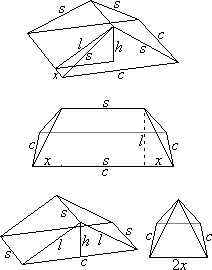

(In the diagrams to the left, x = (c – s) / 2.) Combining these equations gives
We solve for the height h to find
or h = s / 2.
Now we can calculate the volume VP of each of the six pyrimidal objects:
Then the volume of the dodecahedron is
